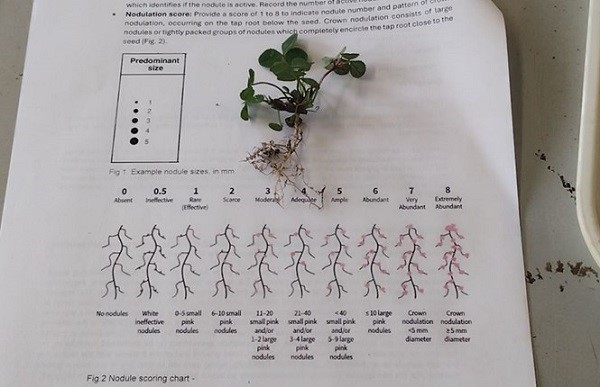An update on the living clover mulch trial at Strategic Cereal Farm North
Tuesday, 22 October 2024
Strategic Cereal Farm North is investigating whether a living leguminous mulch can boost the productivity of the farm’s cash crops. Henny Lowth explains how the trial has been set up and provides initial results.
It is easy to see the appeal: grow something alongside the cash crop that can minimise the waste of light energy, fix free nitrogen, contribute to weed control and boost soil health. What’s not to like?
Before I joined AHDB, I worked at the Organic Research Centre, where I was involved in an Innovative Farmers field lab project that used clover as a living mulch in on-farm trials.
The approach showed potential, but it was not perfect. We occasionally saw yield penalties in the cash crops (compared with standard farm approaches).
Some weeds, especially certain grass weeds and aggressive perennial weeds, became more challenging too (although, overall weed pressures tended to reduce).
However, when it came to soil health, the benefits were much clearer. The mulch led to better nitrogen availability, higher soil organic matter levels and stronger earthworm populations.
The merit of the approach was clear, but we were just scratching the surface.
When David Blacker, host of Strategic Cereal Farm North, expressed an interest in running living mulch trials on his farm, I was delighted.
Working with our research partners at ADAS, Charlotte White and Anne Bhogal, we first tried to establish a permanent clover understory in autumn 2023, before planting a spring bean crop in 2024.
Unfortunately, the wet winter and spring proved too much for the clover and the beans, with the field written off and left fallow.
This summer, we dusted off the plan and made a second attempt to establish the clover before planting winter wheat.
Trial approach
Susie Roques at ADAS helped us plan the trial to ensure it delivers sufficient yield data for statistical analysis (using ADAS’ Agronomics package).
The treatments are:
- Winter wheat without compost
- Winter wheat with compost
- Winter wheat with clover without compost
- Winter wheat with clover and compost
We are using double tramlines (full length) to set up the treatments.
The clover mix, which comprises yellow trefoil (20%), white clovers (60%) and subterranean clover (20%), was drilled and rolled on 9 July 2024.
At that time, compost applications were made to one half of each double tramline (equivalent to 30 t/ha and 250 kg/ha total nitrogen). This created distinct compost/no-compost treatment areas overlaid with the clover/no-clover treatments.
Initial assessments
At the end of August, Charlotte and Anne made initial assessments of the clover.
In addition to checking the above-ground biomass, they looked at how well the clover was forming precious root nodules and if these were fixing nitrogen.
They used a quadrat (a 0.5 m2 frame) to select representative treatment areas.
In each quadrat, they carefully dug up five clover plants. Once transferred to the laboratory, soil was gently removed from the roots (by hand and by soaking).
Each plant was given an overall root nodulation score, which increased based on the:
- Number of nodules
- Size of the nodules
- Presence of active nodules (pink when cut open)
For example, a plant with no nodules was scored as 0, whereas a plant with extremely abundant active nodules was scored as 8.
Nodule scoring chart

The addition of compost significantly increased the number of nodules in the white clover in the legume mix.
It also resulted in a significantly higher overall nodulation score, although nodule size was similar to the no-compost treatment.
All nodules were active.
Nodulation assessment results
| Treatment | Number of nodules | Size of nodules (mm) | Nodulation score |
|---|---|---|---|
| Legume understory, no compost | 9.0 | 1.3 | 2.3 |
| Legume understory, with compost | 12.4 | 1.1 | 3.2 |
| Mean | 10.7 | 1.2 | 2.8 |
| T-test probability (P) value | 0.05* | 0.157 | 0.006* |
| Standard error of the difference (SED) | 1.6 | 0.116 | 0.293 |
The above assessment is based on an average of two plots per treatment and five plants per plot.
*Indicates a significant difference.
Next steps
Winter wheat will now be direct drilled across the trial field.
The team will take numerous measurements of the crop, mulch and soil throughout the growing season to help assess the impact of each treatment. This includes measuring changes to earthworms, soil nitrogen supply and crop performance.
 headshot for bio.JPG)


